Join us as we embark on a journey across North America to explore the continent’s top 10 largest airports by land area.
North America sees a lot of air travel activity. U.S. Airlines carried 862.8 million passengers on flights, within the country and abroad in 2023. Although passenger numbers at U.S. Airports have been rising again after the impact of the COVID 19 they have not yet reached the levels seen in 2019 when, around 926.4 million passengers were recorded.
It’s no surprise that the ten largest airports in North America by land area are all situated in the United States. Toronto Pearson International Airport, in Canada falls short of making the list with its size of 18.67km2 (7.2 square miles). Meanwhile Mexico City International Airport in Mexico covers an area of just 7.5km2 (2.9 square miles).
Airports are more than just landing strips and departure lounges. They’re sprawling complexes that act as vital transportation arteries, economic engines, and even miniature cities within themselves. But not all airports are created equal. Some stand out not just for their passenger volume but for their sheer size. Today, we embark on a journey across North America to explore the continent’s largest airports by land area.
What are the largest airports in North America in terms of their land area?
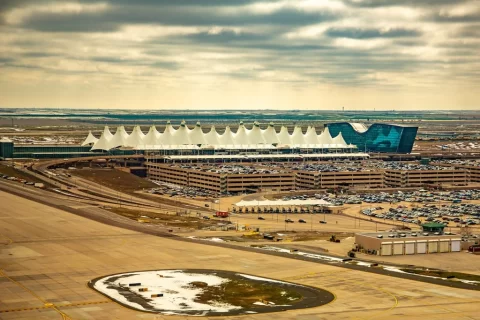
-
Denver International Airport (DIA), Colorado: 135.69km²
The undisputed champion when it comes to land area is Denver International Airport (DIA). This behemoth in Colorado stretches across a staggering 135.69 square kilometers (52.4 square miles). Yes, you read that right! That’s an area larger than the size of Manhattan and Brooklyn combined! DIA boasts six runways, one of which holds the title for the longest public-use runway in the United States. Imagine the logistics of coordinating takeoffs and landings across such a vast space!
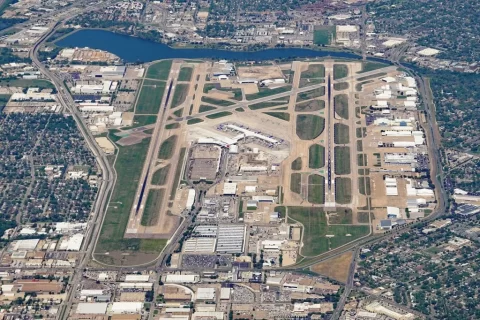
2. Dallas/Fort Worth International Airport (DFW),Texas: 69.63km²
Following Denver’s reign is the impressive Dallas/Fort Worth International Airport (DFW) in Texas. Clocking in at 69.63 square kilometers (27 square miles), DFW is a true titan in the Lone Star State. This massive airport serves as a major connection point for travelers across the globe, handling over 73 million passengers annually.
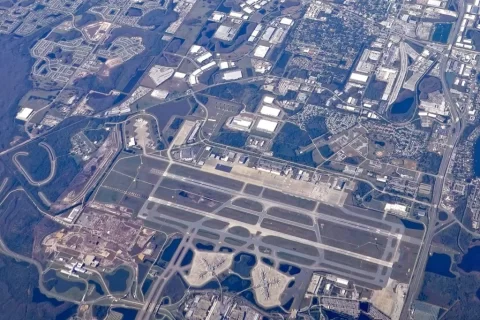
Read also: The 5 largest Airports in Canada, North America
3.Orlando International Airport (MCO),Florida. 53.83km²
Florida joins the party with Orlando International Airport (MCO), encompassing a sizeable 53.83 square kilometers (20.8 square miles). Given its proximity to world-famous theme parks and other tourist destinations, MCO is a constant hive of activity, welcoming millions of travelers each year seeking a dose of sunshine and adventure.
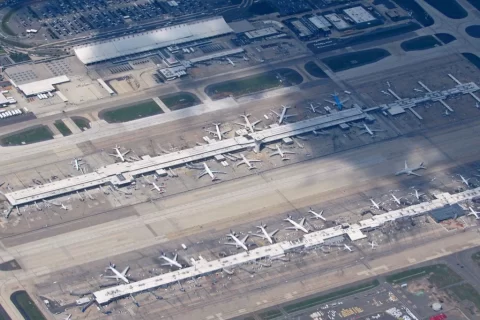
4. Washington Dulles International Airport (IAD), Washington DC: 52.6km²
The political heart of the US, Washington D.C., isn’t left behind. Washington Dulles International Airport (IAD), stretching across 52.6 square kilometers (20.3 square miles), serves not just the metropolitan area but acts as a major international gateway, connecting the US to destinations worldwide.
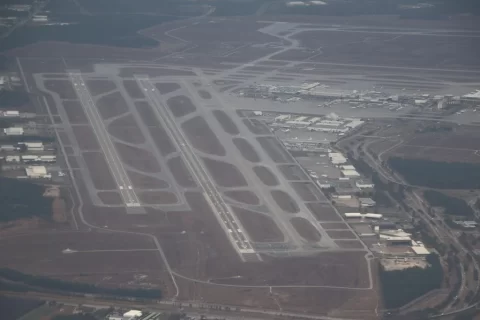
Read also: Top 10 largest airports in the USA
5. George Bush Intercontinental Airport (IAH), Texas: 40.46km²
George Bush Intercontinental Airport (IAH), located in Texas, sprawls across an expansive 40.46 square kilometers. As one of the largest airports in North America, IAH serves as a critical transportation hub for both domestic and international travel. With its extensive network of flights connecting passengers to destinations worldwide, IAH plays a pivotal role in facilitating the movement of millions of travelers each year. Situated in the Houston metropolitan area, the airport serves as a major gateway to Texas and the southern United States, contributing significantly to the region’s economy and connectivity.
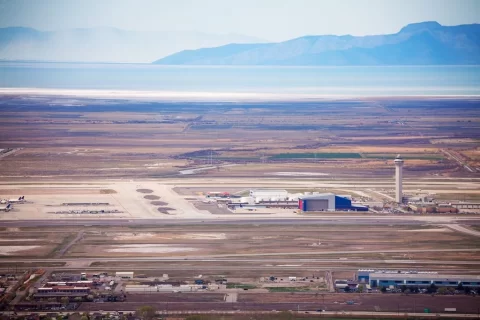
6. Salt Lake City International Airport (SLC), Utah: 31.16km²
Salt Lake City International Airport (SLC), nestled amidst the stunning scenery of Utah, proves this point. While occupying a respectable 31.16 square kilometers (12 square miles), SLC excels in efficient operations, serving as a major connection point for Delta Air Lines.

7. O’Hare International Airport (ORD), Illinois: 30.86km²
O’Hare International Airport, situated in Illinois covers an expanse of 30.86 square kilometers. Being, among the most bustling airports in North America O’Hare acts as a center for domestic and international flights accommodating millions of travelers annually. With its ranging amenities and prime spot in the Chicago region O’Hare serves a vital function in linking passengers to various destinations, across the globe.
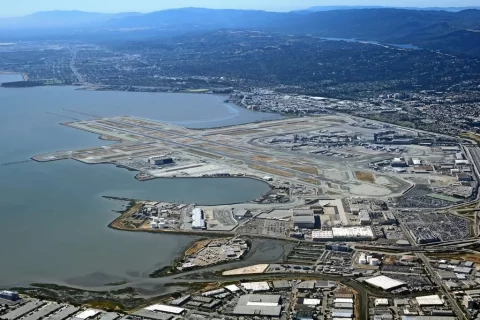
Read also: Top 10 Largest Airport Projects Globally
8. San Francisco International Airport (SFO), California: 21.07km²
San Francisco International Airport, located in the state of California covers an area of 21.07 square kilometers. Known for its design and smooth functioning SFO serves as an entry point, to the San Francisco Bay Area and surrounding areas. Handling a significant volume of domestic and international flights, this airport serves as a key transportation hub, welcoming travelers with its modern amenities and breathtaking views of the Bay Area’s iconic landmarks.
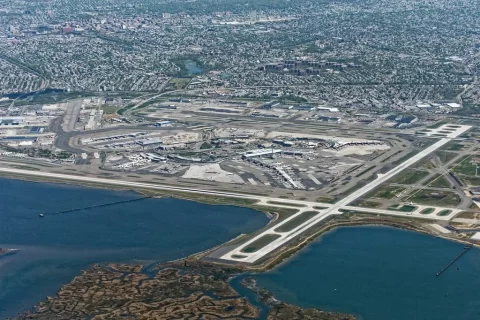
9. John F Kennedy International Airport (JFK), New York: 21.04km²
JFK Airport, located in New York covers an area of 21.04 square kilometers and ranks ninth among the largest airports in North America based on land area. JFK airport serves as a critical connection point for both domestic and international flights. With its range of flight options linking passengers to destinations JFK plays a key role in facilitating the travel of millions of people annually. Its strategic positioning within the New York region not only serves as an important entry point to the United States but also stands out as a significant symbol of excellence, in air travel.
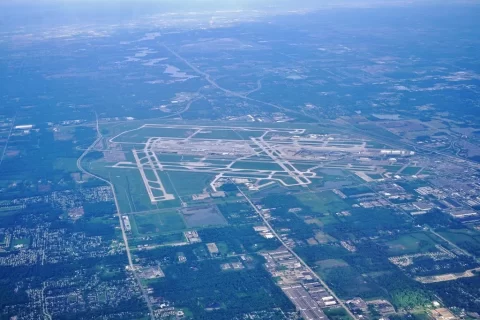
10. Detroit Metropolitan Airport (DTW), Michigan: 19.6km²
Detroit Metropolitan Airport (DTW), in Michigan is number 10 in our list of largest airports in North America based on land area covering an expansive 19.6 square kilometers. It serves as a transportation center for the area handling an amount of both local and international air travel. Thanks to its amenities and efficient services the airport plays a role in linking travelers to destinations worldwide. Located within the Detroit metropolitan region DTW acts as an entry point, to Michigan and the wider Great Lakes area bolstering growth and connectivity in the region.
Read also: World’s oldest airports still in operation

